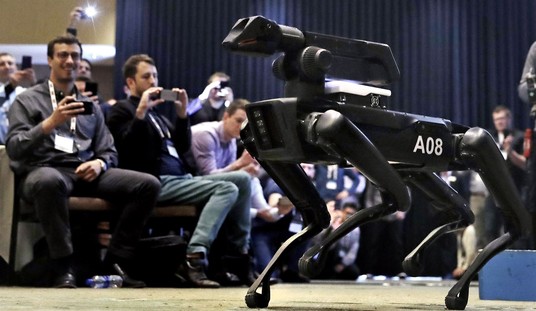The White House finally released the e-mail string that led to the creation of the talking points for the Benghazi terrorist attack that somehow completely missed the fact that it was a terrorist attack. Did that succeed in having the Obama administration’s argument that it reflected the best intelligence at the time? Not if you read page 57, in which everyone on the e-mail circuit was informed of this:
On Friday evening at 9:43 pm, the CIA acknowledged that “FBI says AQ (not AQIM) was involved and they are pursuing that theory. So we are not ahead of law enforcement now[,]” referring to an earlier concern that identifying this as a terrorist attack would interfere with the FBI’s investigation of the attack. However, almost immediately thereafter, even the more generic mentions of purposeful attacks involving Islamic extremists disappear from the talking points, which left Susan Rice with little more to offer than a demonstration involving a YouTube video — a video which, it should be pointed out, never gets mentioned in the e-mail string.
Who made that decision? It’s difficult to say. The CIA did a lot of the editing on the talking points, but as Politico notes, much of that was driven by State Department concerns about how the information would reflect on them:
As the number of people handling the Benghazi talking points grew, the amount of information the document offered shrank.
Emails and documents released by the White House Wednesday reveal an editing process that valued caution over comprehensiveness as officials worked to remove language that would have assigned blame for the attack or suggested ways the incident could have been prevented. The release also showed that the CIA, and not the State Department, made the decision to scrub references to al Qaeda, al Qaeda linked groups, and prior terrorist attacks in the region.
But the newly public email chains suggest it was the State Department that was most concerned about taking the blame for the attack. State Department spokeswoman Victoria Nuland sought changes to the talking points that would shield the agency — then led by Secretary of State Hillary Clinton — from congressional accusations that it had failed to properly secure the post, given the unstable situation in that area.
At one point, Nuland even wrote to a chain of administration officials relaying her concern that the talking points could be used as a cudgel against the State Department.
Interestingly, Politico never picks up on the reference on page 57 that the FBI had already figured out that al-Qaeda was involved, and not the local branch/affiliate. Neither, for that matter, does Jake Tapper at CNN. Jon Karl doesn’t mention the FBI assessment on page 57, but does note another excised passage:
The emails confirm the ABC News report that the so-called “talking points” written by the CIA on the attack underwent extensive revisions – 12 versions – and that substantial changes were made after the State Department expressed concerns.
The early versions of the talking points, drafted entirely by the CIA, included references to the al Qaeda affiliate Ansar al-Sharia and to previous CIA warnings about terror threats in Benghazi. State Department spokesman Victoria Nuland expressed concerns about including those references in the talking points. …
The following sections were crossed out and removed from later drafts:
- “On 10 September the Agency notified Embassy Cairo of social media reports calling for a demonstration and encouraging jihadists to break into the Embassy.”
- “… as to who is responsible for the violence, although the crowd almost certainly was a mix of individuals. That being said, there are indications that Islamic extremists participated in the violent demonstrations.”
- “The wide availability of weapons and experienced fighters in Libya almost certainly contributed to the lethality of the attacks.”
- “The Agency has produced numerous pieces on the threat of extremists linked to al-Qaeda in Benghazi and eastern Libya. Since April, there have been at least five other attacks against foreign interest in Benghazi by unidentified assailants, including the June attack against the British Ambassador’s convoy. We cannot rule out that individuals had previously surveilled the US facilities, also contributing to the efficacy of the attacks.”
One official, whose name was redacted from the email chain, responded to the changes: “They are fine with me. But, pretty sure HPSCI won’t like them :-)” HPSCI refers to the House Permanent Select Committee on Intelligence, members of which had requested the talking points.
Stephen Hayes, another reporter whose work the White House wanted to refute, wrote later that the release confirmed his and Karl’s accounts:
The documents, first reported by THE WEEKLY STANDARD in articles here and here, directly contradict claims by White House press secretary Jay Carney and Secretary of State Hillary Clinton that the revisions of those talking points were driven by the intelligence community and show heavy input from top Obama administration officials, particularly those at the State Department.
The emails provide further detail about the rewriting of the talking points during a 24-hour period from midday September 14 to midday September 15. As THE WEEKLY STANDARD previously reported, a briefing from the Office of the Director of National Intelligence shows that the big changes came in three waves – internally at the CIA, after email feedback from top administration officials, and during or after a meeting of high-ranking intelligence and national security officials the following morning.
The initial CIA changes softened some of the language about the participants in the Benghazi assault – from “Islamic extremists with ties to al Qaeda” to “Islamic extremists.” But CIA officials also added bullet points about the possible participation of Ansar al Sharia, an al Qaeda-linked jihadist group, and previous warnings about the deteriorating security situation in Benghazi. Those additions came out after the talking points were sent to “the interagency,” where the CIA’s final draft was further stripped down to little more than boilerplate. The half dozen references to terrorists – both in Benghazi and more generally – all but disappeared. Gone were references to al Qaeda, Ansar al Sharia, jihadists, Islamic extremists, etc. The only remaining mention was a note that “extremists” had participated in the attack.
As striking as what appears in the email traffic is what does not. There is no mention of the YouTube video that would become a central part of the administration’s explanation of the attacks to the American people until a brief mention in the subject line of emails coming out of an important meeting where further revisions were made.
Hayes notes that Hillary Clinton’s and Jay Carney’s attempts to shove the changes off onto the CIA were less than honest. Mike Morell made the changes, but on the urging of State:
Carney, in particular, is likely to face tough questioning about the contents of the emails because he made claims to reporters that were untrue. “The White House and the State Department have made clear that the single adjustment that was made to those talking points by either of those two – of these two institutions were changing the word ‘consulate’ to ‘diplomatic facility,’ because the word ‘consulate’ was inaccurate,” he told reporters on November 28, 2012.
That’s not true. An email sent at 9:15 PM on September 14, from an official in the CIA’s Office of Public Affairs to others at the agency, described the process this way. “The State Department had major reservations with much or most of the document. We revised the document with their concerns in mind.”
That directly contradicts what Carney said. It’s also difficult to reconcile with claims made by Secretary of State Hillary Clinton during testimony she gave January 23 on Capitol Hill.
“It was an intelligence product,” she said, adding later that the “intelligence community was the principal decider about what went into talking points.” (See here for the original version of the talking points and the final one.)
The result? We have an unequivocal statement almost in the exact middle of the evolution of these data points that the FBI had already determined that the attack involved al-Qaeda, which shouldn’t have come as a surprise to anyone, considering that the attack took place on the anniversary of the original 9/11 attacks. Yet the final product, pushed in large part by State, eliminated all but the most ambiguous of suggestions that extremists had conducted an attack. The talking points as communicated on September 16th added in the YouTube video nonsense to which the administration clung through the funerals and Obama’s speech to the UN late in September before finally giving it up.
How did the YouTube video get added to the State Department presentation? How did everyone manage to ignore the FBI’s investigative direction and produce talking points that suggested almost the total opposite? Those are questions the HPSCI should ask, and demand answers.
Update: Eli Lake certainly noticed the FBI’s analysis, and also thinks the CIA is getting off too easy for its decision to trust the local militia for security.









Join the conversation as a VIP Member